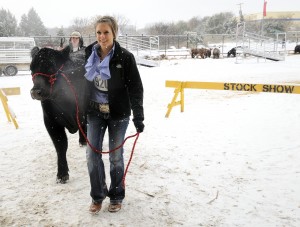Why It Takes a Lot of Snow To Equal a Small Amount of Rain

Max Faulkner/Fort Worth Star-Telegram/MCT
Sarah Lucas, of Ennis, Texas, guides her European Cross Steer to the Steer Show in the snow at Fort Worth Stock Show, Friday, February 4, 2011, in Fort Worth, Texas.
Texas is seeing its first real winter storm this weekend, and already parts of the Panhandle are seeing trace amounts of snow.
Snow is welcome precipitation for a part of the state that is still struggling with extreme drought. But it takes a lot of snow to have the same effect as just a small amount of rain.
Light dusting of snow at Palo Duro Canyon State Park in the Panhandle
— TX Parks & Wildlife (@TPWDparks) November 22, 2013
“In general, one inch of snow is the equivalent about .10 inch of rain. So, ten inches of snow would be one inch of rain,” says Victor Murphy, Climate Program Manager with the National Weather Service Southern Region.
That 10:1 ratio means it would take an extraordinary amount of snowfall to provide real drought relief in the Panhandle. Big snow events in the past in the Panhandle rarely go above five inches, which would equal a half-inch of rain. A big snow season can total over 40 inches, i.e. just four inches of rainfall equivalent overall. But snow is not without its benefits.
“At least snowfall sort of seeps slowly into the ground,” Murphy says. “That’s good for rebuilding the soil moisture, which is a positive thing.”
The latest extended drought outlook from the National Oceanic and Atmospheric Administration predicts there won’t be much relief for West Texas this winter.
“It’s not good news for Western Texas,” says Murphy, “but probably pretty good news for East Texas.”
And in the middle, in places like Austin, where East and West Texas meet? “That’s going to be of critical importance,” Murphy says. “And unfortunately that’s where Lakes Travis and Buchanan lies. And it’s very, very difficult to see how that area makes something in the next three months or so.”
Due to historically low inflows into those Highland Lakes, most rice farmers along the Lower Colorado River are likely to be cut off from water for irrigation for a third year in a row.

